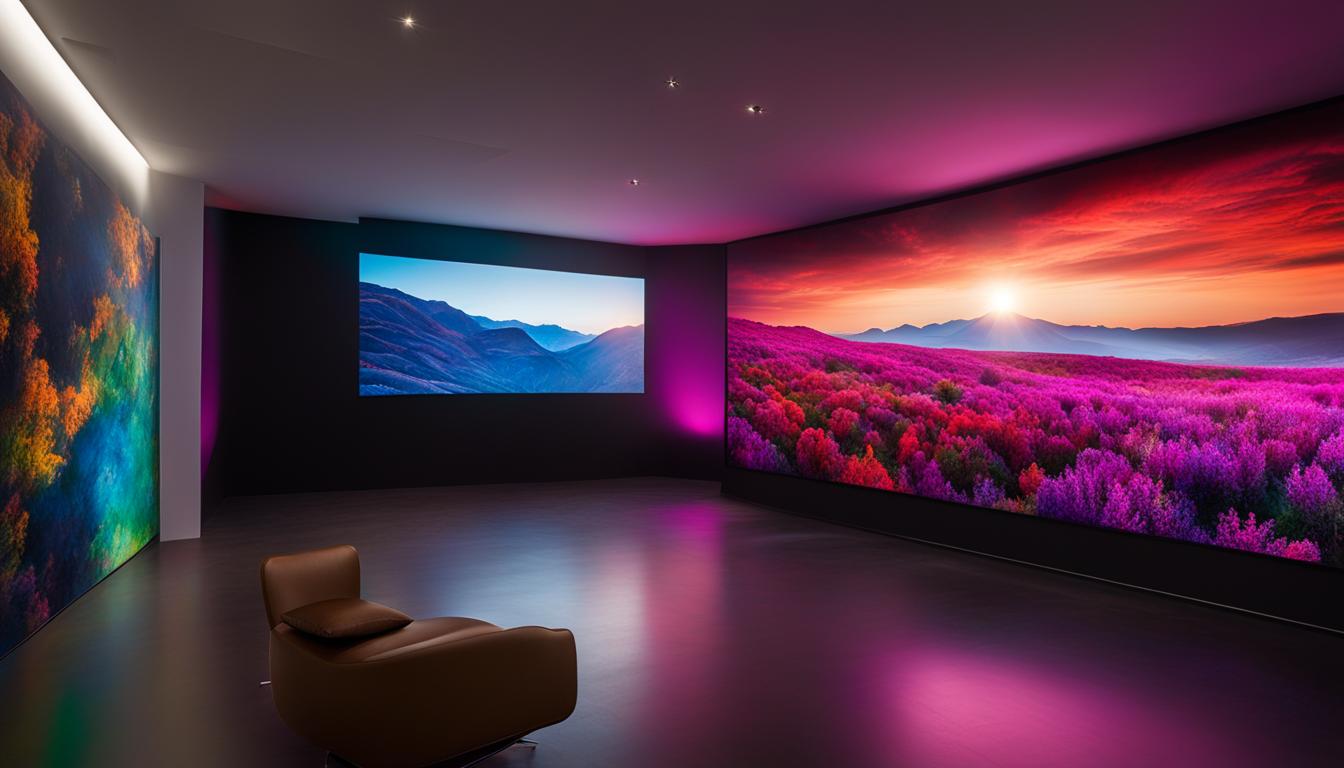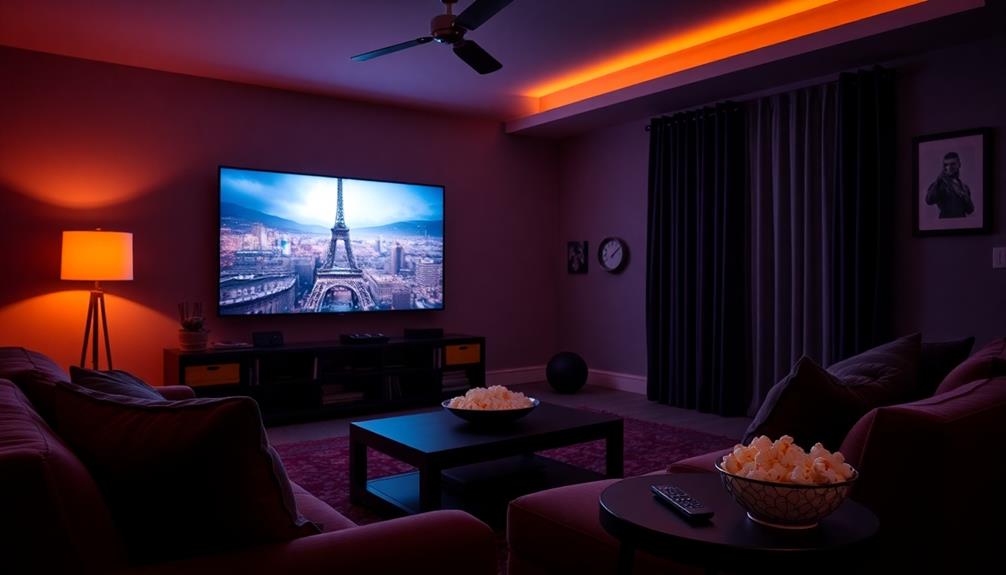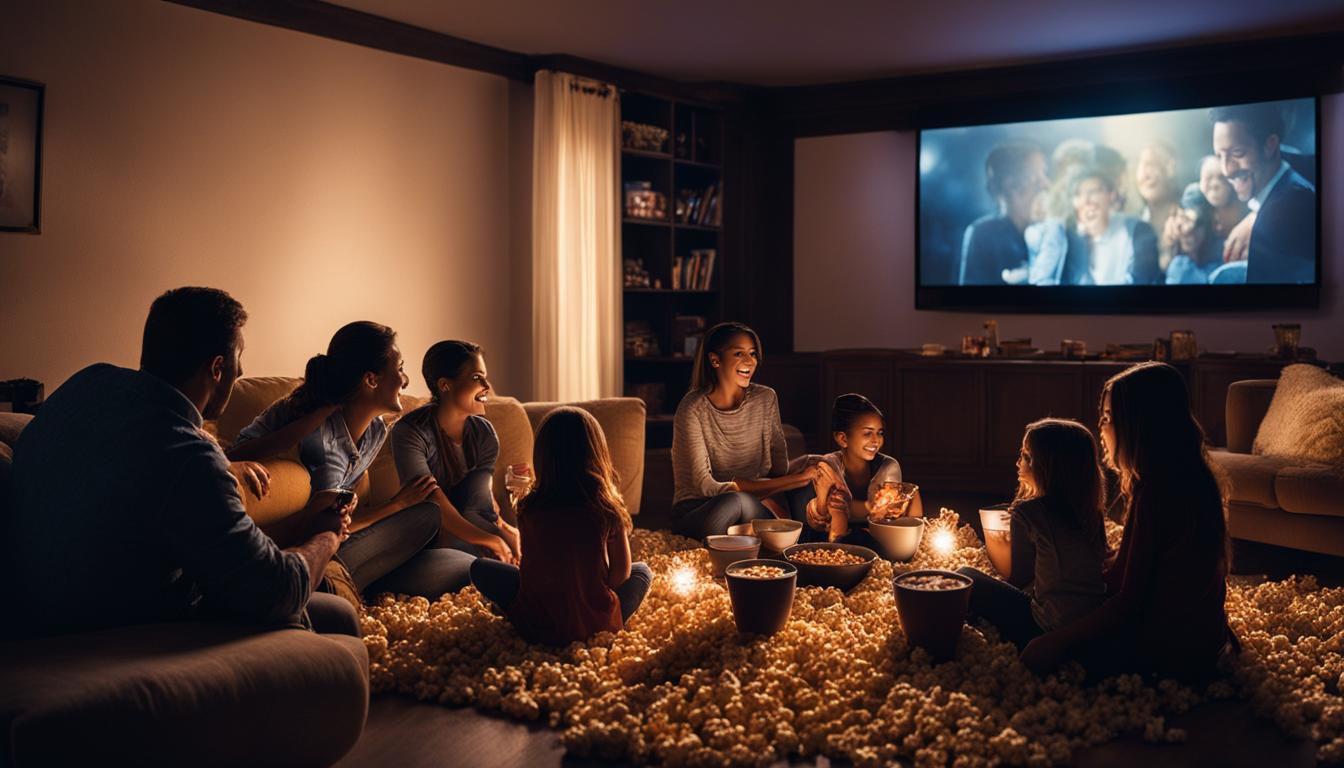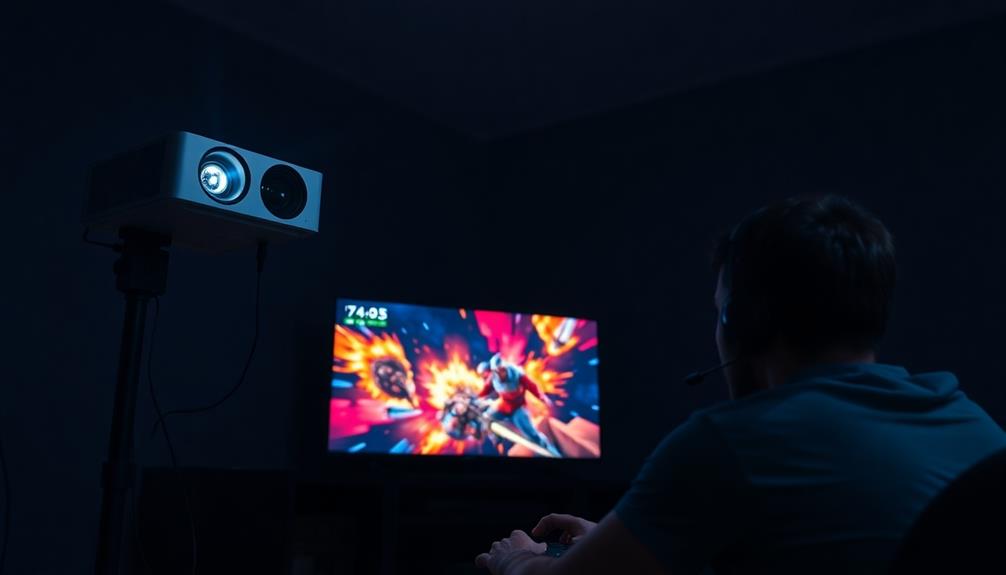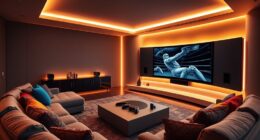To create a dual-purpose room with a hidden projector setup, start by choosing a versatile space like a living room. Opt for a high-quality projector with a retractable screen to save space. Install the projector discreetly, either mounted on the ceiling or in a cabinet, to keep things tidy. Focus on sound quality by positioning speakers effectively and using acoustic treatments. Enhance the atmosphere with cozy seating and adjustable lighting. Don't forget to maintain your projector for peak performance. Explore more tips to elevate your room while keeping it functional.
Key Takeaways
- Select a versatile space with minimal sunlight and easy access to power outlets for projector setup and other activities.
- Choose a high-quality projector with at least 1080p resolution and a retractable screen for a seamless, space-saving solution.
- Install the projector using ceiling mounting and implement cable management to maintain a tidy and clean appearance.
- Utilize cabinets or curtains to conceal the projector and screen, enhancing room aesthetics and functionality.
Choosing the Right Space

When choosing the right space for your dual-purpose room, pick an area that offers enough room for both the projector setup and your intended secondary function. Look for a versatile space, like a living room or den, where you can enjoy both activities without feeling cramped.
The room's layout is essential; consider how furniture arrangement can facilitate easy changes between using the projector and other functions, such as reading or socializing. Additionally, implementing good projector maintenance tips can enhance the longevity and performance of your setup, guaranteeing a better viewing experience.
Pay attention to natural light sources, as minimizing direct sunlight will enhance the projector's visibility and overall viewing experience. Confirm you have access to power outlets for the projector and any additional equipment, like sound systems or streaming devices. This prevents the hassle of relying on extension cords that can clutter your space.
Acoustics also play a significant role; select a room with soundproofing potential to improve audio quality while reducing distractions during secondary activities.
Selecting a Projector and Screen

How do you choose the right projector and screen for your dual-purpose room to guarantee an impressive viewing experience? Start by focusing on a high-quality projector with at least 1080p resolution for clear and vibrant images.
Look for a retractable screen, ideally around 80 inches, that can be mounted above a window to save space and keep your room looking tidy when not in use.
Here are some key features to evaluate:
- Short-throw capabilities: This allows you to maximize image size while minimizing the distance needed from the screen, perfect for smaller rooms.
- Keystone correction: This feature helps you adjust the image shape for a perfect fit, even if the projector isn't perfectly aligned.
- Zoom function: It offers flexibility in image size without moving the projector.
- Multiple HDMI ports: Confirm seamless connectivity to your streaming devices for a variety of content options.
Installation Techniques

Installing your projector and screen correctly is essential for achieving an ideal viewing experience in your dual-purpose room. Start by measuring the distance between the projector and the screen; typically, this should be 1.5 to 2.5 times the width of the screen to guarantee peak image quality.
For flexibility, choose a high-quality projector with keystone correction and zoom functions to adjust the image as needed.
Consider ceiling mounting the projector for a clean, clutter-free setup. This not only provides better ventilation but also allows for easy access for maintenance.
When it comes to the screen, a retractable screen is a great choice. Use suspension U-hooks for installation, allowing you to store the screen discreetly when it's not in use.
Don't forget about cable management; utilize cable sleeves or conduits to keep power and HDMI cables hidden, enhancing the room's aesthetic.
Concealment Options

Exploring various concealment options can help you seamlessly integrate your projector into your dual-purpose room while maintaining a stylish and organized appearance. Here are some effective concealment options to take into account:
- Cabinets: These can stylishly hide your projector, offering integrated cable management and protecting your equipment from dust.
- Media Consoles: With dedicated compartments, media consoles effectively conceal projectors and cables, allowing for easy access when needed.
- Floating Shelves: This minimalist approach lets you customize height and positioning, blending the projector seamlessly with your decor.
- Curtains: Use curtains to elegantly conceal projectors and screens, providing a decorative element that you can easily draw aside for immediate use.
Enhancing Sound Quality

To truly enhance your sound quality, you need to pay attention to both speaker placement and acoustic treatment.
Positioning your speakers at ear level and using soundproofing materials can drastically improve your audio experience.
Speaker Placement Techniques
Proper speaker placement is vital for achieving ideal sound quality in your dual-purpose room, guaranteeing an immersive audio experience while maintaining a sleek design. Here are some key techniques to enhance your setup:
- Position at Ear Level: Place your speakers at ear level when seated for maximum sound projection and clarity.
- Distance & Balance: Keep speakers about 3-5 feet apart to guarantee balanced audio distribution.
- Wall Mounting: Utilize wall mounting or bookshelf placement to reduce clutter while enhancing sound quality.
- Angling Speakers: Angle your speakers towards the primary seating area at about 30 degrees to create a more immersive audio experience.
Additionally, connecting your speakers to a quality amplifier or receiver is vital for maximizing sound output.
Don't overlook the power of a subwoofer, which adds depth to your audio experience, making your projector setup feel even more cinematic.
Acoustic Treatment Options
Acoustic treatment options play a crucial role in enhancing sound quality, guaranteeing your dual-purpose room delivers an immersive audio experience.
Start by strategically placing acoustic panels on the walls to absorb sound reflections, which will greatly improve the overall audio environment. You can also add a soundproof curtain; it'll minimize external noise interference while effectively concealing the projector and screen when not in use.
Incorporating rugs and carpets is another great way to dampen sound transmission and reduce echo, making your movie nights even more enjoyable. Additionally, consider installing bass traps in the corners of the room to manage low-frequency sounds, which guarantees a balanced audio output for both movies and music.
Don't forget about furniture upholstery! Using pieces with soft materials can further enhance sound absorption, creating a comfortable space designed for entertainment and relaxation.
Creating an Inviting Atmosphere

To create an inviting atmosphere in your dual-purpose room, focus on the right lighting and cozy seating arrangements.
Dimmable lights can set the perfect mood for movie nights or quiet reading, while comfortable chairs make it easy to relax.
Pair these elements with a few decorative touches, and you'll transform the space into a welcoming retreat.
Ambiance Through Lighting
Creating the right ambiance through lighting transforms your dual-purpose room into an inviting space for both movie nights and quiet reading sessions. To achieve this cozy atmosphere, consider the following lighting strategies:
- Dimmable LED lights: Adjust brightness levels to suit different activities, enhancing comfort and engagement.
- Ambient lights: Use floor lamps or wall sconces to create a warm glow without glare on the projector screen, ensuring ideal viewing conditions.
- Smart lighting systems: Control your lights through smartphone apps for quick adjustments that match your mood or activity, adding convenience to your space.
- Blackout curtains: Eliminate unwanted daylight during projector use, while allowing natural light when you want to read or study.
Cozy Seating Arrangements
Comfortable seating arrangements play an essential role in making your dual-purpose room feel inviting, whether you're enjoying a movie or settling in with a good book.
Start by selecting comfortable seating options like bean bags, lounge chairs, or a sectional sofa. These choices create cozy seating that encourages relaxation and enjoyment.
Arrange your seating in a semi-circle or angled configuration to foster conversation and connection while ensuring ideal viewing angles for your hidden projector setup.
Adding soft textures, such as plush throw blankets and cushions, enhances comfort and invites you to settle in for extended periods.
Consider incorporating a small side table or ottoman for easy access to snacks and drinks. This promotes a casual environment that supports both entertainment and study sessions.
Finally, utilize ambient lighting, like floor lamps or string lights, to create a warm atmosphere that complements your cozy seating arrangements.
Together, these elements work in harmony to create a space that's perfect for relaxation and enjoyment, making it an inviting haven for all your dual-purpose activities.
Maintenance and Upgrades
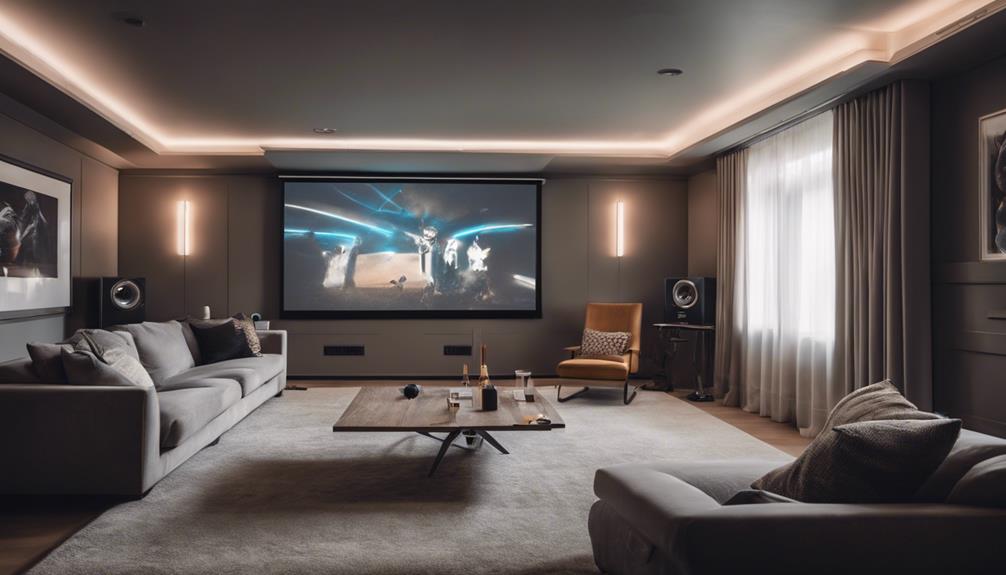
Regular maintenance and thoughtful upgrades are essential for keeping your hidden projector operating at peak performance and ensuring an exceptional viewing experience. Neglecting these aspects can lead to diminished picture quality and potential equipment failure. Here are some key maintenance tips and upgrade considerations:
- Clean the projector lens regularly with a microfiber cloth to prevent dust buildup, which can degrade picture quality.
- Monitor lamp hours and replace bulbs as needed; most projectors have a lifespan of 2,000 to 5,000 hours.
- Ensure proper ventilation by keeping air vents clear and dust-free to avoid overheating issues.
- Update firmware periodically through the manufacturer's website to enhance functionality and fix bugs.
Frequently Asked Questions
How to Hide a Projector in a Living Room?
To hide a projector in your living room, use a media console for storage, install retractable ceiling mounts, or incorporate decorative screens. Creative solutions like art pieces can also disguise it while ensuring proper ventilation.
How to Set up a Room With a Projector?
To set up a room with a projector, measure the distance for ideal image quality, choose a suitable placement, connect it to power and devices, and adjust settings for clarity while considering ambient light.
How to Link Two Projectors Together?
Linking two projectors together isn't rocket science, but it's almost magic! You'll need matching resolutions, an HDMI splitter, and maybe a video switcher. Keep them equidistant for a flawless viewing experience you'll love!
Will a Bed Sheet Work as a Projector Screen?
Yes, a bed sheet can work as a projector screen. Just use a white or light-colored sheet, keep it taut and wrinkle-free, and adjust the distance for the best image quality.
Conclusion
By weaving together your dual-purpose room with a hidden projector, you're crafting a seamless tapestry of functionality and flair.
Like a magician revealing a stunning trick, you can transform your space at the flick of a switch, enchanting guests with cinematic experiences or cozy gatherings.
Embrace the art of versatility, where every inch of your room tells a story.
With thoughtful design and a touch of creativity, your hidden gem will shine brightly, ready to entertain and inspire.
Hello, I’m Art, and I’m excited to be a part of the 1Home Theatre Projector team. As a writer, I’m here to contribute my knowledge and insights to help you achieve the ultimate home cinema experience. I understand that making decisions in the world of home entertainment can be complex, and I’m here to simplify the process for you.









